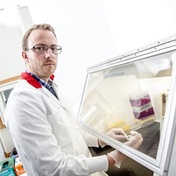Lui Sang, now 81, was diagnosed with leprosy as a boy shortly after his older brother came down with the same infection, notorious for centuries for causing disfiguring skin lesions and stigma.
Now, patients such as Lui -- who lost his left leg -- may be helping not only in eradicating leprosy but in battling another ancient scourge, tuberculosis.
"My brother, 4 years older, died of starvation in the 1960s because nobody took care of him. I was sent to this colony," Lui said, referring to a village in Lianjiang in southern China where lepers in the area were interned in the past.
China stopped institutionalising patients with leprosy, also known as Hansen's disease, after an antibiotic treatment was introduced in 1982 and leprosy was reclassified as just another skin disease that would be treated on an outpatient basis.
But thousands of recovered patients like Lui, and even more of their descendents, continue to languish in hundreds of such villages in China because of the rejection they would suffer if they rejoined the society outside.
An ancient disease that has affected humans for at least 4,000 years, leprosy is not as highly infectious as people long feared. Doctors believe it is transmitted via droplets from the nose and mouth of an infected person.
Caused by the bacteria Mycobacterium leprae and M lepromatosis, leprosy damages the skin and nerves, causing disfigurement and sometimes numbness that can make patients prone to injury. Most people are immune.
But a group of geneticists in China and Singapore recently discovered variants of seven genes that appear to increase a person's susceptibility to the disease -- overturning the age-old belief that leprosy is not congenital or inherited.
"That means part of the risk can be inherited," said team member Liu Jianjun, team leader of human genetics at the Genome Institute of Singapore (GIS).
"If a person has (5) out of these 7 genes ... to some degree (leprosy) can be transmitted, inherited. The chance for you to be infected, that chance is higher than for other normal people. Genetic defect plays a role here."
The researchers compared genes of 706 leprosy patients in eastern China to those of 1,225 people without the disease and found that the seven variants turned up consistently in Hansen's patients. The study was published in the New England Journal of Medicine in December.
NUMBER OF NEW CASES REMAIN STEADY
This may explain why, despite an effective and free multi-drug treatment, there is a steady average of 1,600 new cases in China each year.
There were nearly 250,000 new cases globally in 2008, more than half of them in India.
"If you have effective treatment, the disease should be wiped out but that's not the case," Liu said in an interview.
Fan Guoshun, who makes prosthetic limbs and shoes for China's recovered leprosy patients, may be another one such case.
Fan, whose parents and maternal grandfather suffered from the disease, remembers having blisters on his hands when he was 11. Skin lesions are a symptom of leprosy.
But they soon vanished and other symptoms -- numbness in his hands and disappearing facial hair -- appeared when he was 23.
"I was diagnosed with the disease and I took drugs for two years and then recovered," said Fan, 35, and now a father of two daughters aged 4 and 5.
Liu says veteran doctors in China long suspected genetics played a role, having seen children of patients become infected while spouses escaped.
"In terms of exposure, children and spouses have at least equal (exposure) if not more for the spouse," Liu said.
"But why are children more likely to get infected instead of the spouse? That is telling me that genes play a role."
LESSONS FOR TB?
The team of geneticists are preparing for the next phase of their research to quantify how often children of cases get infected as compared with spouses.
"The group is trying to go back to get some families and see whether genes explain why the children get it more easily or if there are additional factors there," Liu said.
Both phases of the study are funded largely by China.
The country has thrown its financial weight behind its geneticists and given them a relatively free hand to find ways to harness genomics to improve human medicine, animal cloning and understanding of plant biology.
Its interest in leprosy is driven by an urgent need to combat drug-resistant forms of tuberculosis, which belongs to the same class of bacteria as leprosy.
China, saddled with the world's second largest TB burden after India, has 4.5 million TB cases currently. Each year, 1.4 million people fall ill with the disease. It killed 160,000 people in the country in 2008.
"Because leprosy is of the same family as TB, it gives us an indication of the general human response to this class of mycobacteria," said Edison Liu, executive director of GIS.
"The more we understand the human response to this class of pathogens, the more we understand how to treat. Understanding the mechanism is very good, but we understand the mechanism in such a way we can pinpoint targets for therapeutics."
The world's only TB vaccine is 100 years old and there has been no new TB drug for more than 40 years. But the resurgence of TB due to AIDS has forced the West back into TB research in the last 20 years and a string of experimental drugs and vaccines are now in the pipeline. (- Reuters, May 2010)




 Publications
Publications
 Partners
Partners










